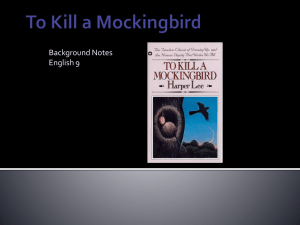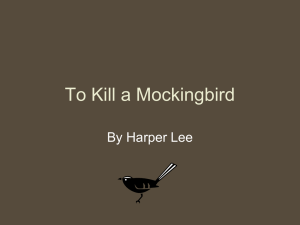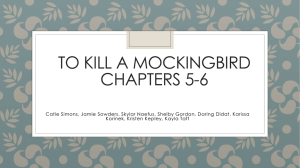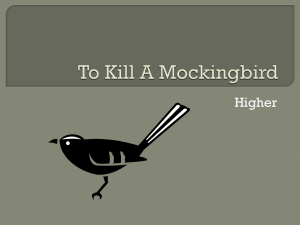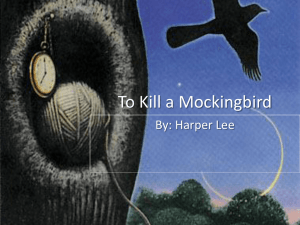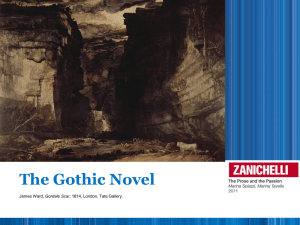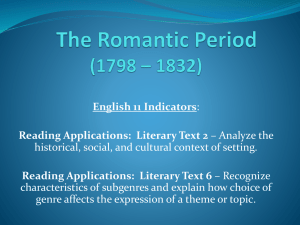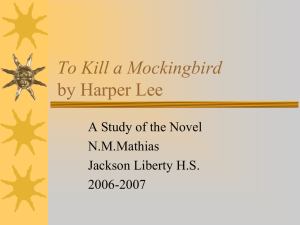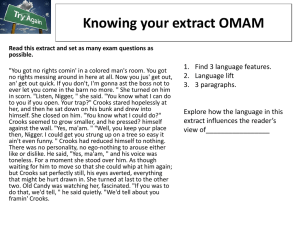To Kill a Mockingbird a Southern Gothic Novel by
advertisement
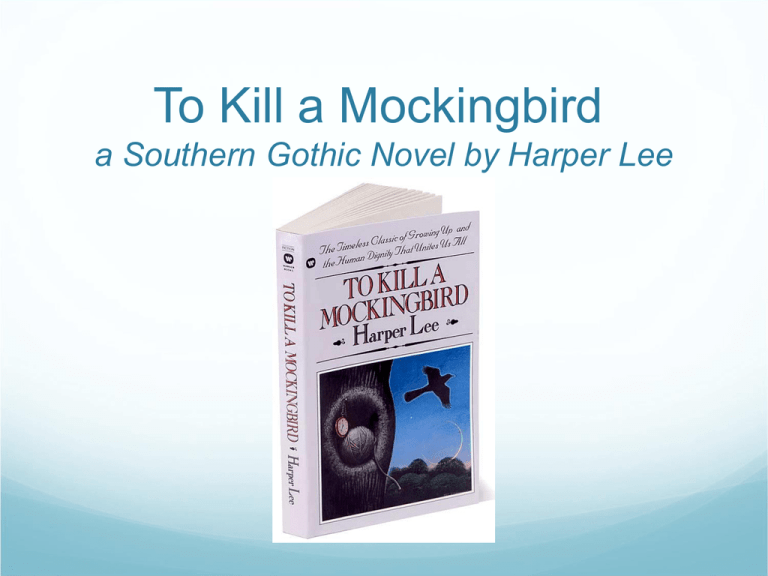
To Kill a Mockingbird a Southern Gothic Novel by Harper Lee Harper Lee Born April 28, 1926 About the author Harper Lee grew up in Monroeville, Alabama Her father, a lawyer and state legislator, was a descendant of General Robert E Lee Lee was an avid reader and from a young age wanted to become a writer Attended University of Alabama and later moved to NYC to pursue a writing career After two years of writing and revising, To Kill a Mockingbird was published in 1960 About the novel To Kill a Mockingbird was an immediate success Won the Pulitzer Prize in 1961 Voted best novel of the century by Library Journal in 1999 1991 survey by the Library of Congress asked readers to rank books that had made a significant difference in their lives. TKM ranked second after the Bible. TKM is the only novel Lee ever published For more than 40 years, Lee has declined to comment on her novel, letting it speak for itself Gothic Literature Gothic Literature is defined as Germanic and medieval Popular in the early 19th century Common characteristics like brooding atmosphere, haunted castles/mansions, isolated settings, ghosts, spirits, vampires, mysterious disappearances/reappearances, supernatural occurrences, sensational plot lines Central Aim – to evoke terror in its reader American Gothic Mid 18th century onwards Teresa A Goddu suggests that the gothic has “an intimate relation to the romance” and thus “American literature is infiltrated by the popular, the disturbing, and the hauntings of history.” She further suggests that “American gothic literature criticizes America’s national myth of new-world innocence by voicing the cultural contradictions that undermine the nation’s claim to purity and equality.” American Gothic Cont. “Showing how these contradictions contest and constitute national identity even as they are denied, the gothic tells of the historical horrors that make national identity possible yet must be repressed in order to sustain it.” Examples of contemporary American gothic include the horror fiction of Stephen King and the vampire fiction of Anne Rice Southern Gothic Often seen as the primary site of American gothic because the South is the repository of values and attributes not necessarily welcome in the rest of the country Edgar Allan Poe cited as the first writer of gothic and his status as a Southerner makes him the first southern gothic writer Issues of race, alienation, and otherness are central to southern gothic Southern Gothic Cont. Toni Morrison, in Playing in the Dark: Whiteness and the Literary Imagination (1992), wrote: Black slavery enriched the country’s creative possibilities. For in that construction of blackness and enslavement could be found not only the not-free but also, with the dramatic polarity created by skin color, the projection of the not-me. The result was a playground for the imagination. What rose up out of collective needs to allay internal fears and to rationalize exploitation was an American Africanism – a fabricated brew of darkness, otherness, alarm and desire that is uniquely American. (Quoted by Goddu, 74) Southern Gothic Cont. "My mother, Southern to the bone, once told me all Southern literature can be summed up in these words: `On the night the hogs ate Willie, Mama died when she heard what Daddy did to Sister.'" Pat Conroy From the South Watch web page (http://www.uncg.edu/~rsginghe/far9596.htm) Gothic Elements in TKM Race: Trial of Tom Robinson based on deep racial fears Otherness: Boo Radley is an unseen and unknown figure hence he is a ghost like presence in the novel; the Ewells, Cunninghams and other country folk are the others to Scout Alienation: many characters are profoundly alienated from their culture – Scout, Atticus, Miss Maudie, Mrs. Dubose Setting: the crumbling mansions and homes of the south, as well as the crumbling southern way of life, are analogous to the castles and medieval settings of British gothic Hauntings and the Supernatural: the mysterious gifts in the knothole in the tree, the rescue from the murder attempt, these are examples of supernatural like events Style Bildungsroman: “novel of education” or “novel of formation” – Lee chooses a form of fiction that explicitly deals with the maturation of its protagonist Protagonist - Hero Antagonist - Villain Duality: the novel is structured at virtually every level around dualities. The tension created by the opposition of themes, narrative points of view, communities, genders and so on provides a cohesiveness in the novel. Narration: double-layered narration is used. The mature Scout explicitly tells the story at the outset of the novel and at its end. In the middle, the story is told from the perspective of Scout as a child. However, there are points in the novel where the two narrators are almost co-existing. Possible Conflicts Jem breaking his arm Radley house – explanation left unfinished; mystery Miss Caroline? Might be an antagonist. Style Cont. Language: Lee employs colloquial language – esp. in the speech of the characters (dialogue) and in the descriptions of setting Metaphors: Lee employs several central metaphors in the novel: Mockingbird Snowman Mad dog Boo Radley Clothing – esp. Scout’s clothes Buildings Theme Theme is the underlying meaning of the story, a universal truth, a significant statement the story is making about society, human nature, or the human condition. The theme of a fable is its moral. The theme of a parable is its teaching. The theme of a piece of fiction is its view about life and how people behave. Theme Continued In fiction, the theme is not intended to teach or preach. In fact, it is not presented directly at all. You extract it from the characters, action, and setting that make up the story. In other words, you must figure out the theme yourself. The writer's task is to communicate on a common ground with the reader. Although the particulars of your experience may be different from the details of the story, the general underlying truths behind the story may be just the connection that both you and the writer are seeking. Themes Race Relations History vs. the Present Growing up Conformity vs. Individuality Search for Identity Gender Roles America divided Stereotypes Exposed Justice vs. the Law Myths of Childhood Innocence Compassion Education Prejudice/Discrimination Good vs Evil Social Inequality Morals Courage/Bravery Characters Scout – narrator; girl; 6 years old; good reader; first grade; teacher doesn’t like her; her teacher is threatened by Scout’s intelligence; Finch; Finch Family – Simon Finch was stingy. Methodist. Pious. Owned slaves. Trapper. apothecary (old time pharmacist). Died rich. Land rich. Atticus Finch – Jem and Scout’s Dad. Lawyer (attorney). Atticus’ brother (John Hale Finch) - doctor Charcters Jem – boy; 5th grade; 10 years old; Scout’s older brother; broke his arm; loves football; doesn’t want to hang with Scout at school; close to Scout at home Dill – neighbor (summer with Miss Rachel); boy; friends with Jem and Scout; curious boy; points out mysteries in neighborhood; 7 years old; little; Southern; talkative; Charles Baker Harris Miss Caroline Fisher – Scout’s teacher; doesn’t like Scout because Scout already knows how to read; 21; high heels; peppermint; bad first impression Characters Arthur “Boo” Radley – Son of Mr. Radley. Lives in the Radley house. Neighbor to Jem and Scout. High strung at times. Mr. Radley locked him away and for 15 years he was never seen. One day, Boo stabbed his dad. He was 33 years old. Calpurnia – Finch’s cook; woman; teaches Jem and Scout handwriting; like a mother to Jem and Scout; strong; black Compassion Thematic Statement: A lot, some none Finches have much compassion Each other Tom Robinson Tom’s family Calpurnia Atticus to kids Boo Neighbors – Mrs. Dubose Compassion Compassion: a feeling of deep sympathy and sorrow for anothwho is stricken by misfortune, accompanied by a strong desire to alleviate the suffering. Aunt Alexandra Towards Scout; Motherless/ Tomboy Tom Robison has compassion for Mayella Scout has compassion for Jem – wants to help him heal Compassion Atticus has compassion for Boo Sheriff has compassion for Boo – Mr. Ewell “fell on his knife” Boo has compassion for the kids – saves them from Mr. Ewell Atticus has compassion for the Cunnighams. Accepts food from Mr. C for legal service. Mr. C has compassion for Atticus when the mob came. Compassion Black community have compassion for Atticus – reverse racism for defending Tom; stand and support him as he leaves the courtroom. Rev Sykes towards the kids – let’s them sit with him in the courtroom. Atticus has compassion for Dill – he treats him as one of his own Miss Rachel – let’s Dill stay for the summer Aunt Alexandra has compassion for Atticus – hard to be a single parent Compassion Thematic Statement: Compassion can be expressed in many different ways. We all need to have compassion for others. We comes in different ways and towards different people. Different people show compassion in different ways. We all need to have compassion for others because it encourages others and makes them feel good. If you have compassion, you will go far in life.
